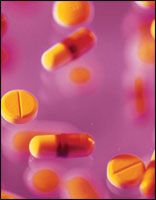Publication
Article
Pain Relief: Striking the Right Balance
Author(s):
Misconceptions about medications to treat chronic pain persist;patient education and proper adherence are critical to ensure that patients accrue maximum benefit from analgesics.
Ms. Wick is a senior clinical researchpharmacist at the National CancerInstitute, National Institutes ofHealth, Bethesda, Maryland. Theviews expressed are those of theauthor and not those of any governmentagency.

Pain has received a considerableamount of attention sincethe Joint Commission encouragedhealth care providers to considerit the fifth vital sign. Treating acutepain is quite straightforward. When painbecomes chronic, providing optimal painmanagement requires a fine balancebetween the patient's needs and beliefs,analgesic availability, clinician skill, andthe law.
Most pharmacists are familiar with theWorld Health Organization's pain ladder,which indicates that mild pain should betreated with OTC drugs or prescription-strengthnonsteroidal anti-inflammatorydrugs (NSAIDs) with or without adjuvanttreatments (antidepressants, anticonvulsants,etc). If pain is of moderateintensity, stepping up to an opioid suitablefor moderate pain, with or withouta nonopioidanalgesic and adjuvants,is appropriate. The final step—severepain—is treated with the strongest ofthe opioids, again, with or without additionalnonopioidsor adjuvant treatments.Clinicians should schedule round-the-clockanalgesics and encourage patientsto adhere to therapy. This model wasdeveloped for chronic malignant pain. Ateach step, other modalities (eg, psychologicaltherapy and rehabilitative therapies)can help improve function andensure that patients accrue maximumbenefit from analgesics.
In the past, pain experts could notagree on a model addressing chronicnonmalignant pain. Today, a few controlledstudies and many uncontrolledstudies validate opioid use in chronicnonmalignant pain.1-7 Opioids provideeffective analgesia with acceptable sideeffects in a wide range of chronic nonmalignantpain conditions.8,9 Manyclinicians and patients still avoidopioids, however, as myths andmisconceptions about the medicinespersist. They often have concernsabout addiction, intolerableand potentially dangerous sideeffects, and functional deterioration.10,11 Regulatory scrutiny also isa concern for clinicians.11
The treatment goal for chronicnonmalignant pain is to relievethe pain and improve function.7Complete pain relief may not beachievable or realistic (and thisis a key point that patients andclinicians must understand), butimproved functioning usually is.Prescribers who treat patients withchronic pain usually develop specificgoals for functional improvementwith individual patients.12,13 Thesemay be as simple as, "The patient willbe able to garden for 1 hour by the endof the week," and pharmacists can askpatients if they understand what theirspecific functional goals are.
When the patient takes aspirin, acetaminophen,or NSAIDs regularly, counselingshould begin with inquiring aboutthe dose and dosing schedule if the analgesicis OTC. In addition, ask the patientabout aspirin allergies and allergies toother pain relievers. Scan the patient'sprofile for anticoagulants, and ask aboutany history of gastrointestinal (GI) bleedingor ulcers. Patients who have liver disease,or those who consume 3 or morealcoholic beverages a day, should avoidacetaminophen. It is prudent to remindpatients that many OTC and prescriptionpain medicines contain acetaminophen;they need to read labels carefully, so theydo not approach or exceed the maximumdaily dose (4 g/day for adults; 2.4 g/day forseniors and people with hepatic impairment).
Many NSAIDs are available in bothOTC and prescription forms, which oftenconfuses patients. If they receive a prescription-strength NSAID, explain that itis stronger than the OTC version, andalso tell them what brand and genericnames are the same medication. TheFDA has revised labeling for all prescriptionNSAIDs to include a boxed warningstressing the potential for increasedrisk of adverse cardiovascular events.14In addition, patients also need to beaware that the risk of GI bleeding is wellestablished, and they should know whatsigns to watch for. Dose reductions maybe necessary if they have renal impairment.Should patients need to step up toopioid relief, pharmacists will need toask them about their beliefs and concerns. Patients who fear addiction (anunpredictable, compulsive, psychologicalcraving for euphoria that appears in 10%to 20% of the population) will need tounderstand its difference from abuse anddependence. Adhering to medicationsas prescribed prevents abuse. Physicaldependence is predictable, and patientsusually develop some degree of physicaldependence after receiving opioids regularlyfor more than 5 to 7 days. Patientswho take opioids chronically for pain willexperience withdrawal if they stop themabruptly, reduce their dose too quickly, orreceive an opioid antagonist. If treatmentmust be discontinued, using a taperingregimen helps to avoid withdrawal.15
Sometimes, explaining that a similarphenomenon can occur with the chronicuse of many classes of medications—including nitro vasodilator therapy,α2-adrenergic agents, corticosteroids,and antidepressants—helps take awaysome of the trepidation.16 Avoid usingstigmatizing terms, such as "addiction"and "detoxification," to describe patientswho are physically dependent on opioids.16 Opioid use for pain managementis seldom associated with the developmentof addiction, unless a patient has apredisposition to substance abuse priorto opioid therapy.1,15,17 Pseudoaddictionis a term used to describe behavior thatmay occur when pain is undertreated,but this condition is beyond the scope ofthis article.15,16,18
Tolerance to opioids' desired (analgesic)and undesired (adverse) effects willdevelop, but rates vary among patients.19,20Tolerance predictably creates the need formore frequent doses, or increasing doses,to achieve the same effect.21,22 Tolerancedoes not indicate addiction.23 This differentialrate of development explains the safeuse of large doses of opioids in patientswithout causing respiratory depression.20,22If tolerance to analgesia develops, it oftendevelops slowly.
To delay the development of tolerance,clinicians often combine opioids withnonopioids or adjunctive therapy, whichenhances analgesia.
Side effects cause nonadherence moreoften than tolerance to analgesia does.Counseling patients that certain sideeffects will lessen with time is imperative(Table).
Chronic pain can be treated successfullyas long as the patient and all membersof the health care team recognize that agoal of a completely pain-free existencemay be unreasonable. Additionally, iftreatment includes opioids, every memberof the team needs to stress properadherence, meaning that neither overadherencenor underadherence is acceptable.Sadly, it also means paying carefulattention to record keeping, in the eventthat the regulatory agency has questions.Perhaps some day, we will have drugsthat provide pain relief without the shadowof abuse and addiction complicatingprescribing.
Table 2
Tolerance to Opioid Side Effects
Side Effect
Counseling Point
Cognitive: sedation, confusion, mood changes and sensory changes (eg, visual and auditory illusion, hallucinations, and delirium)
• Cognitive effects usually occur during the first 2 weeks oftherapy or following a dose increase, although toleranceto these effects usually develops rapidly
• Opioid-dependent patients (ie, those stabilized on longtermopioid therapy) may retain driving skills
• The greatest potential impairment occurs during the firstfew days of use and during the first few hours after adose change
Nausea and vomiting
• In most patients, tolerance develops during the firstweek of therapy
• Prophylactic antiemetics may be needed in patients witha history of motion sickness or severe opioid-inducednausea
Constipation: a reduction in bowel movement frequencyto less than 1 every 3 days, or difficulty passing stool
• Tolerance to the GI effects of opioids develops veryslowly, if at all. Constipation is likely to persist in mostpatients
• Prophylactic use of stimulating cathartic drugs (eg, bisacodyl,senna), with the addition of stool softeners, particularlyin the elderly or in patients with coexisting GIpathology, is crucial
• Encourage increased fluid and dietary fiber intake
Respiratory depression
• Rare when the opioid dose is carefully titrated to thepatient's pain
• If clinically significant respiratory depression occurs,administer opioid antagonists, titrated carefully to preventopioid withdrawal symptoms
GI = gastrointestinal.
Adapted from references 5, 15, 19, and 23-36.
References
- Aronoff GM. Opioids in chronic pain management: is there a significant risk of addiction? Curr Rev Pain. 2000;4:112-121.
- Moulin DE, Iezzi A, Amireh R, Sharpe WK, Boyd D, Menskey H . Randomised trial of oral morphine for chronic non-cancer pain. Lancet. 1996;347:143-147.
- Jamison RN, Raymond SA, Slawsby EA, Nedeljkovic SS, Katz NP. Opioid therapy for chronic noncancer back pain. A randomized prospective study. Spine. 1998;23:2591-2600.
- Rowbotham MC, Twilling L, Davies PS, Reisner L, Taylor K, Mohr D. Oral opioid therapy for chronic peripheral and central neuropathic pain. N Engl J Med. 2003;348:1223-1232.
- Allan L, Hays H, Jensen NH, et al. Randomised crossover trial of transdermal fentanyl and sustained release oral morphine for treating chronic non-cancer pain. BMJ. 2001;322:1154-1158.
- Ytterberg SR, Mahowald ML, Woods SR. Codeine and oxycodone use in patients with chronic rheumatic disease pain. Arthritis Rheum. 1998;41:1603-1612.
- Gimbel JS, Richards P, Portenoy RK. Controlled-release oxycodone for pain in diabetic neuropathy: a randomized controlled trial. Neurology. 2003;60:927-934.
- Portenoy R. Opioid therapy for chronic nonmalignant pain: a review of the critical issues. J Pain Symptom Manage. 1996;11:203-217.
- Bartleson JD. Evidence for and against the use of opioid analgesics for chronic nonmalignant low back pain: a review. Pain Med. 2002;3:260-271.
- Roth SH. A new role for opioids in the treatment of arthritis. Drugs. 2002;62:255-263.
- Nedeljkowic SS, Wasan A, Jamison RN. Assessment of efficacy of long-term opioid therapy in pain patients with substance abuse potential. Clin J Pain. 2002;18(4 Suppl):S39-S51.
- Kalso E, Allan L, Dellemijn PLI, et al. Recommendations for using opioids in chronic non-cancer pain. Eur J Pain. 2003;7:381-386.
- Marcus DA. Tips for managing chronic pain. Implementing the latest guidelines. Postgrad Med. 2003;113:49-50, 55-56, 59-60 passim.
- An analysis and recommendations for Agency action regarding non-steroidal anti-inflammatory drugs and cardiovascular risk. www.fda.gov/cder/drug/infopage/COX2/NSAIDdecisionMemo.pdf. Accessed February 17, 2008.
- Cherny NI. Opioid analgesics: comparative features and prescribing guidelines. Drugs. 1996;51:713-737.
- American Pain Society. Liaison Committee on Pain and Addiction. Definitions Relating to the Use of Opioids for the Treatment of Pain. www.ampainsoc.org/advocacy/opioids2.htm. Accessed February 17, 2008.
- Savage SR. Opioid therapy of chronic pain: assessment of consequences. Acta Anaesthesiol Scand. 1999;43:909-917.
- Weissman DF, Haddox JD. Opioid pseudoaddiction--an iatrogenic syndrome. Pain. 1989;36:363-366.
- Nicholson B. Responsible prescribing of opioids for the management of chronic pain. Drugs. 2003;63:17-32.
- Anderson S, Leikersfeldt G. Management of chronic non-malignant pain. Br J Clin Pract. 1996;50:324-330.
- American Society of Addiction Medicine. Public policy statement on definitions related to the use of opioids in pain treatment. J Addict Dir. 1998;17:129-133.
- Foley KM. Misconceptions and controversies regarding the use of opioids in cancer pain. Anticancer Drugs. 1995;6(Suppl 3):4-13.
- Inturrisi CE. Clinical pharmacology of opioids for pain. Clin J Pain. 2002;18(4 Suppl):S3-S13.
- O'Mahony S, Coyle N, Payne R. Current management of opioid-related side effects. Oncology (Williston Park). 2001;15:61-73, 77; discussion 77-78, 80-82.
- Fishbain DA, Cutler B, Rosomoff HL, Rosomoff RS. Are opioid-dependent/tolerant patients impaired in driving-related skills? A structured evidence-based review. J Pain Symptom Manage. 2003;25:559-577.
- Zacny JP. A review of the effects of opioids on psychomotor and cognitive functioning in humans. Exp Clin Psychopharmacol. 1995;3:432-466.
- O'Neill WM, Hanks GW, Simpson P, Fallon MT, Jenkins E, Wesnas K. The cognitive and psychomotor effects of morphine in healthy subjects: a randomized controlled trial of repeated (four) oral doses of dextropropoxyphene, morphine, lorazepam and placebo. Pain. 2000;85:209-215.
- Sjogren P, Olsen AK, Thomsen AB. Neuropsychological performance in cancer patients: the role of oral opioids, pain and performance status. Pain. 2000;86:237-245.
- Banning A, Sjogren P, Kaiser F. Reaction time in cancer patients receiving peripherally acting analgesics alone or in combination with opioids. Acta Anaesthesiol Scand. 1992;36:480-482.
- Vainio A, Ollila J, Matikainen E, Rosenberg P, Kalso E. Driving ability in cancer patients receiving long-term morphine analgesia. Lancet. 1999;346:667-670.
- Bruera E, Macmillan K, Hanson J, MacDonald RN. The cognitive effects of the administration of narcotic analgesics in patients with cancer pain. Pain. 1989;39:13-16.
- Sjogren P, Thomsen AB, Olsen AK. Impaired neuropsychological performance in chronic nonmalignant pain patients receiving long-term oral opioid therapy. J Pain Symptom Manage. 2000;19:100-108.
- Byas-Smith MG, Chapman SL, Reed B, Cotsonis G. The effect of opioids on driving and psychomotor performance in patients with chronic pain. Clin J Pain. 2005;21:345-352.
- Galski T, Williams JB, Ehle HT. Effects of opioids on driving ability. J Pain Symptom Manage. 2000;19:200-208.
- Sabatowski R, Schwalen S, Rettig K, Herberg KW, Kasper SM, Radbruch, L. Driving ability under long-term treatment with transdermal fentanyl. J Pain Symptom Manage. 2003;25:38-47.
- Choi YS, Billings JA. Opioid antagonists: a review of their role in palliative care, focusing on use in opioid-related constipation. J Pain Symptom Manage. 2002;24:71-90.







